When and How to List References on a Resume (w/ Examples)
Many people don’t know whether they should include references on a resume. The problem is that while it used to be standard practice, it’s now something that’s done more by request or on an as-needed basis. Between privacy issues and more accessible information, employers aren’t as readily seeking a list of people who can vouch for you professionally, personally, or otherwise.
Read on to learn all about when, why, and how to list references on your resume, including plenty of examples and tips to assist you in the process.
Do you put references on a resume?
Should you put references on a resume? There has always been a little bit of debate as to whether you should put references on a resume from the start or offer them at a later time. There are also several factors involved in this decision, but the consensus is the same across the board: we don’t really do that anymore.
There are several reasons that references on resume documents have fallen out of fashion. For starters, resumes are no longer as private as they once were. Before the Internet, most resumes were sent to one office, privately, and not exposed to the general public. Therefore, people could include sensitive personal information like resume names, phone numbers, and other contact details.
Today, however, adding that information to a resume is often like sending people’s information out into the ether for anyone to get their hands on—hackers, spammers, and identity thieves are just waiting for unsuspecting people to put information out there in the Internet space. There are several other reasons that the trend of resumes with references is disappearing, but privacy is a big factor.
Of course, there are exceptions to every rule. There are some instances where references on a resume can be helpful. There are also ways to list references so that you’re not compromising privacy, but still showing companies that you have people who can vouch for both your character and your professional capabilities. If you’re asking yourself, “Should I put references on my resume?”, read on.
Pros of including professional references on a resume
Some benefits come from having references readily available on your resume. For starters, it saves you from having to provide them at a later time. Sending a reference page for a resume will show that you’re planning by providing as much information as possible. It can also help lend to your credibility because employers can see that you’re ready with people to sing your praises.
Cons of including work references on a resume
Of course, you also have to consider the potential drawbacks of adding references to your work resume. For starters, it takes up more space and might draw the reader’s attention away from the other parts of the resume, which are far more important. In a lot of cases, as discussed, adding resumes also creates “spillover” onto a second page. That should also be avoided at all costs.
There is also the privacy concern that comes from listing references on a resume. It might be better to create a separate references page for resume submissions and have it available to send on an as-requested basis.
When to list references on a resume
The obvious exception to the “no references” rule is if an employer specifically requests that you provide references on your resume—do it. Make sure that you provide the right type of references, too. If they don’t specify, it’s advised to start with professional references. Then, if they want personal references, they can reach out for further information.
You should also clarify whether they want the references on the resume, or if they are seeking a different document. It’s usually best to provide a separate document with just the references so that they can follow up. After all, your resume already has so much information, and hiring managers will always tell you that in their world, less is more.
How to list references on a resume: Full 6-step guide for 2024
To learn how to write references on a resume, we have prepared a step-by-step guide to assist you.
Step 1: Decide how many references you need
How many references should you have on a resume? This is the age-old question. Most people like the number three, but some jobs may require more (or fewer). Three is a good number to stick with if you’re not sure. You’ll also need to decide whether they are personal or professional references or both.
Protips for this step
If all else fails, ask the employer what they want. Ask how many of which type of references they need, as well as what contact information is required (that will come in handy in a later step).
Step 2: Determine how to add the references
When you are adding references to a resume, there are typically two different ways that you can do it. You can add a separate section for the references at the end of the resume. Some people opt to create a separate document just for the references. This helps ensure that there is no spillover on the original resume. It also provides a more secure way to transmit information.
Protips for this step
If you aren’t sure how you want to do it, consider if there is space for a dedicated reference section on your resume in its current form—will you have to make major changes or reduce the content to make them fit? You can also ask what the employer prefers. Some may want a separate document while others might want them on the same page. Still more might tell you to email them over separately for privacy.
Step 3: Get permission from everyone
There are countless hiring horror stories of people using references without asking. Not only is this in bad form, but it’s also just a bad idea. If you use someone as a reference, they should be expecting a call from the employer. Otherwise, they won’t know to answer the phone or check their email. Not only that, but people might not be comfortable being used as a reference for one reason or another.
It isn’t hard. Just send a quick email or text, or make a quick call and say:
“I’m applying for a position that wants [personal/professional] references; is it okay if I use you as one? And which information should I provide for contact?”
Usually, people will be happy to provide a reference, but in case they aren’t, it’s always safest to ask first.
Protips for this step
Be courteous, always. Never assume that someone is okay with you giving out their information. You also can’t assume that a one-time reference will be someone that you can use on every resume. If nothing else, asking each time lets people know that someone may be reaching out so they can expect the contact.
Step 4: Collect contact information
Once you have permission, you can start collecting any contact information that you don’t already have. Some people have phone numbers and emails handy for their references already, while others have to seek out the information. In either case, make sure that you get the information and ensure that it is accurate. If you don’t know what information you need, it’s best to gather more just to be safe. And remember, the information that you need may vary based on the type of reference being used.
Protips for this step:
Ask the employer how much information they want, which type of contact information they prefer, etc. If you’re being asked to submit references, you want to make sure that you get them right. Perhaps an employer only wants to email people and you only send phone numbers—that isn’t going to work out and it could delay the process.
Step 5: Compile references and their contact details
Now it’s time to compile the references that you have collected and add their information to the resume, or the resume references list. Make sure that you double-check the information at this stage and use care when typing or pasting it into the document. The last thing you need is a wayward typo derailing a reference contact.
Protips for this step:
Use the examples below and available references templates to compile and format your references properly. (More on formatting in the next section)
Step 6: Submit your resume
You’re all done! You have the references listed on your resume or a separate page, and you have verified the contact details. You fixed the formatting and are ready to submit—now just click send, and let the employer do their work. It can take some time for employers to get to references, even when they’re requested, so don’t get too anxious if you don’t get any immediate feedback.
Protips for this step:
Make sure that you are following the employer’s request to the letter. If you’re providing references without a direct request, use standard formatting guidelines for best results.
How to format resume references
Now we’re getting to the important part. Learning where to put references on a resume and how to do it can make or break your chances of success. If you aren’t sure how many references for a resume are required, you can always ask. As an alternative, you can provide 3-4 references, which is a standard number for most employers.
Create a dedicated page or section on your resume
As mentioned, you must have a dedicated space for references that is clearly marked and easy to find. In some cases, it’s better to attach a separate reference sheet for this reason. A separate sheet could also increase the privacy factor and ensure that only people who request references get them.
You shouldn’t mix references in with your job history or try to link them together in any way—the employer can make the connections if necessary and trying to do so will only turn your resume into a mess, and fast. Keep them separate and easily identifiable.
Keep the formatting consistent
You also need to keep formatting consistent between your resume, cover letter, and reference page. This includes the font size, color, and other details, as well as the spacing and other formatting elements. Some people want to use different templates or designs for each element but that can make it difficult for employers to keep track of your documents. Consistency ensures that they know your documents from the rest and will not get things mixed up.
Use a standard list format
Sometimes, people want to get fancy with formatting on resumes, as if that might impress employers. Unfortunately, usually, that only makes things difficult to read and follow. For example, you may see reference lists where people attempt to list them all on a single line using dots or em dashes (—), but that can get confusing and if the formatting gets lost in translation it can be a nightmare.
Professional reference format
- Name
- Title
- Company
- Phone
- Relationship
Personal reference format
- Name
- Relationship/years known
- Phone
Educational reference format
- Name
- Position/Role (teacher, professor, advisor, etc.)
- School
- Phone
- Relationship
Resume references examples
To help you make the most of your resume reference page or list, here are a few examples.
Example 1: Educational references
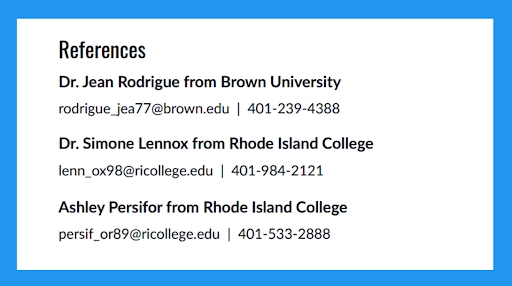
In this references on resume example, you can see the information is clear, direct, and thorough. These are educational references and the candidate has provided their name, school, email, and phone number. Some people will take the extra step and also add the position of the reference or their relationship with the candidate, but it’s not always necessary.
Example #2: Professional references
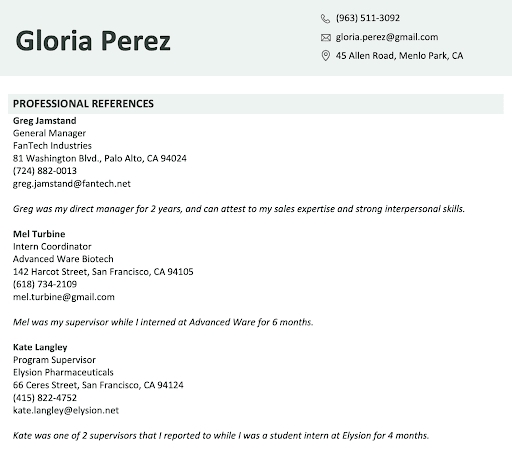
Here is a great example of a professional reference list for a resume. It is shown as a separate page, but she includes her personal information in the matching header for consistency. It includes the name, position, company information, and contact details for each reference. As a bonus, she offers a brief explanation of how each reference relates to her professional experience.
Example #3: Personal references
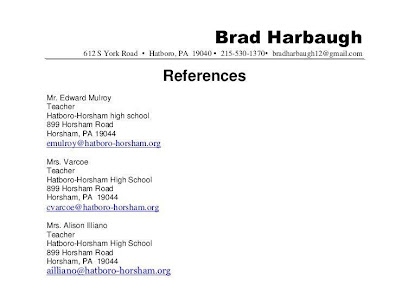
It’s less common for companies to request personal references on a resume or for a job, but if they do, they need to be listed differently. This is another educational list, but it’s former teachers, so it will usually qualify as a personal reference to most employers. If you do list family or friends, you can simply list them as follows:
John Smith – Father-in-Law
Years Known: 12
Phone: 555-123-4567
Email: [email protected]
This allows you to cover the important bases: who they are, how long they’ve known you, and how the employer can get in touch to get the reference.
Example #4: Mixed references
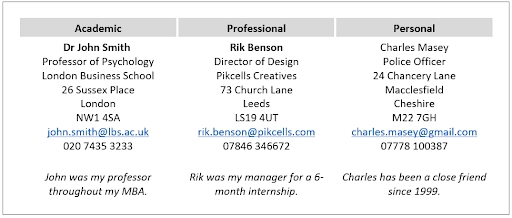
This is a great example of offering a little bit of everything. There is an educational reference, a professional reference, and a personal reference. And, the writer has included all of the necessary contact information and relationship details to help employers understand who they are contacting.
Professional references template
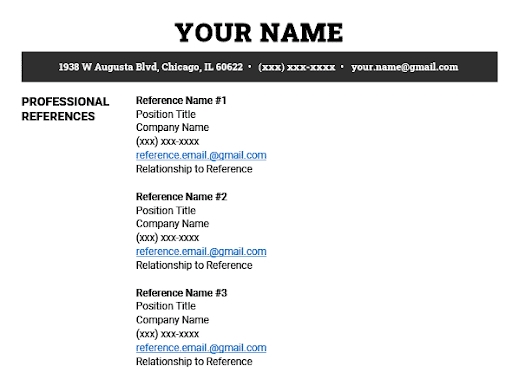
Here is a great resume references template that you can use to create your own resume list for employers. Remember, if you’re using personal or academic references, you can make the necessary adjustments.
Who to ask to be a reference for your resume
There are several people that you can ask to be a reference for your resume, depending on the type of reference that you need:
- Former employers
- Managers and supervisors
- Coworkers and professional peers
- Family and friends (personal references)
- Group leaders (pastors, youth leaders, scout leaders, etc.)
- Teachers, professors, and other educators
How to request references for a resume: 5 tips that work
There are a lot of ways that you can go about asking for references, and for the most part, people are usually more than willing. However, if you want to be sure that you seal the deal, here are five quick-fire tips before we close:
- Choose the people you use as references carefully because they will often impact the employer’s decision.
- Notify references in advance; in addition to asking their permission, let them know what the reference is for and when to expect contact.
- Be polite and explain why you want to use someone as a reference—flattery will get you far.
- Provide details to both references and employers so that everyone knows what to expect.
- Finally, and most importantly, never, ever lie about references. Not only is it in bad form, but we live in the digital age where employers will find out fast that your former supervisor “Cathleen” is actually your sister-in-law.
Key takeaways on references on resumes
There is certainly a case for listing references on a resume, but it may not always be necessary. As you have learned, sometimes it is job-specific, while in other cases, it might be a decision based on a level of skill or the career role. Ultimately, it is best to consider the job at hand and wait until you’re asked to provide references. And when you do, make sure that you format them properly, provide the necessary contact details, and submit them in a professional, easy-to-read format. With these tips, your reference submissions should be a game-changer moving forward.
FAQs
Is it ok to not put references on a resume?
Yes. The general rule of thumb is that you don’t need references on a resume these days. That’s because the references aren’t required until later in the interview and screening process. Most employers won’t even ask for references unless they are considering hiring a candidate. There are exceptions to this, of course.
Is it bad to put “references available upon request” on a resume?
Most experts also suggest that you don’t waste time or space putting “references available upon request” on your resume. It’s assumed by most employers that if they ask for references at any point, you will provide them. Therefore, it’s unnecessary to state the obvious.
The exception, of course, is if a job listing asks for references in the post specifically or if you know that it will be a part of the job interview process. But again, most employers anticipate that candidates can and will provide references as asked.
What are personal vs. professional references?
Personal references refer to family and friends, as well as friends of family, etc. These are people who have known you throughout your life and can vouch for your character. They may also include teachers, pastors, and other mentors or leaders.
Professional references are those who have seen your capabilities and can speak for you on a professional level. These can be coworkers, former bosses and supervisors, or other professional connections that you have made over the years.
Should I include references if my resume is too short?
No. For starters, there is no such thing as a resume that is “too short”—the length designates your experience in the job market. Entry-level candidates are expected to have limited experience. And if someone has had the same position for 10 years, they probably will have a shorter resume because there are fewer jobs. Do not add references just to bulk up the content.
Should you use a friend as a personal reference?
Friends are a great example of a personal reference. Family is usually preferred because they tend to have the most experience with your character. However, if a company requests personal references, you can absolutely use friends, as well as:
- Neighbors
- Teachers
- Family members
- Club leaders
- Etc.
If a company asks for professional references, you should not use friends or family.
Can I put three references on my resume?
Usually, three references are standard. Some employers may ask for more, or they may only want one or two. If your resume has room to include three references without spilling over onto a second page, go ahead. That is, of course, if they were requested by the employer or part of the job posting. Otherwise, again, you can probably just skip them entirely.
Can I have two references on my resume?
Two references are good, but as mentioned above, most will ask for three. No one quite knows where the magic number three came from, but it has been common for almost as long as references have been used. Again, find out what the employer wants and make sure adding references isn’t going to create a spillover page, and you’ll be fine.
How do you list federal references on a resume?
The federal resume format generally requires that you list the federal office or organization, the supervisor’s name and contact information, and their title and relationship to you in the position. Federal resumes usually require a minimum of five references or positions in job history or a combination of the two.
How do you list babysitting references on a resume?
Babysitting references are a little easier than most. Usually, can simply list the name of the parent for which you babysat along with their phone number and/or email address. Be sure to ask permission or let parents know that you are submitting a resume or providing their information as a professional reference.
You should also ask which contact information is okay to share, how they prefer to be contacted, and whether they are comfortable with the submission method (resume, email, etc.).
Sources:
Client provided